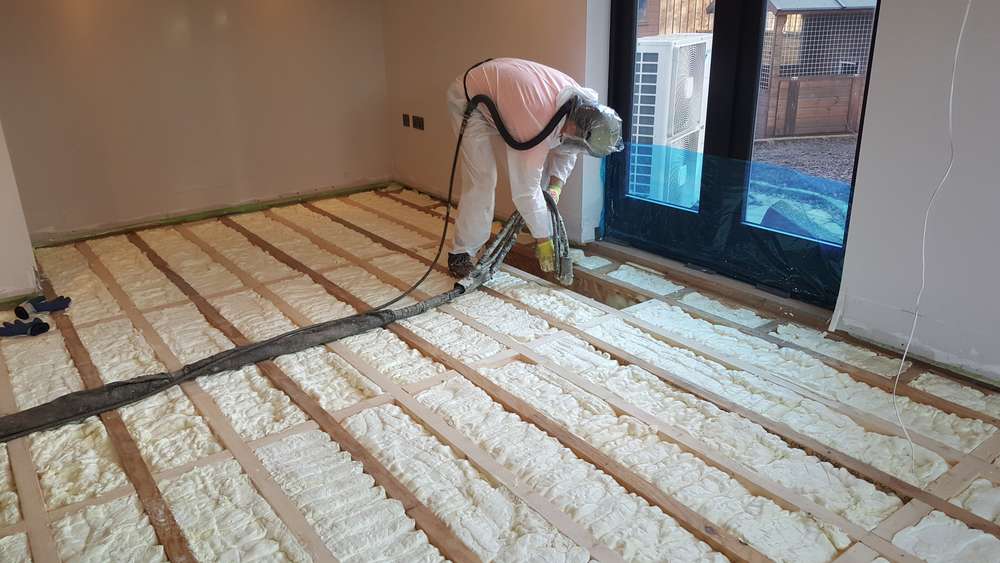Attic Spray Foam Insulation Trim
3 Bed Semi Attic Insulation Trim

Attic Insulation Trim
Spray foam is versatile and can be used for a wide variety of purposes. Spray foam is useful in roofs, windows, attics, underfloor heating systems, interior and exterior walls, as well as roofs.
Spray foam insulation will keep your home warm during winter and cool in summer. It allows moisture-laden air, such as from the basement, to escape thanks to its structure and cell structure.
Benefits of Spray Foam Insulation for your home
Other uses include: commercial and industrial buildings; agricultural farms houses; sheds; shipping containers; vessels; and the refrigeration industry.
It also acts as an airtight shield around the house to keep out cold wind and rain. It allows the heat from your home to escape, which is what most other insulating products today fail to do.


Cost Price Of Spray Foam Insulation
Spray foam insulation can be regarded as the most efficient insulation material. It has a higher U value than other insulating materials such as rock wool, fiberglass and cellulose.
Spray foam insulation is excellent as a sound barrier. It reduces outside noise by up to 50%. This is especially beneficial for companies or homes located in densely populated areas or near airports.
Insulate Your Trim Property Properly
It’s commonly used to block sound from traveling between rooms or floors. It is ideal for bathroom walls as noises from the toilet and showers can often be irritating.
It’s simple to use, and it doesn’t disrupt your everyday activities.
Traditional Irish homes can be insulate in just one day.
The pipes are also protected and insulated to reduce noise.

Boards should be laid over the joists if the loft or attic is to be used for storage. It is not enough to insulate between the joints if you do not cover the entire area.
It is much more effective than fibreglass, rock wool or polystyrene panels when used inside walls, roofs, floors and attics. Because of its dense composition and application process, it creates an airtight envelope. It blocks sound from outside, including traffic, pedestrianised streets, and areas near airports.
Spray foam insulation also stops sounds from within a structure being transmitted to floors below, above, or into adjacent rooms. Spray foam insulation can dramatically reduce noise levels in structures by reducing the frequency of certain noises such as talking, hair dryers and telephones, computer printers and office computers, washing machines, running showers and clothes dryers.
Spray foam insulation is flexible and filled with millions upon millions of microscopic air bubbles. This not only absorbs the vibrations and stops sound from passing through the floor, but also prevents sound from being transferred. Spray foam insulation reduces the transmission and propagation of airborne noises by sealing every crack and crevice.
Spray foam insulation also dampens, if it is not eliminated completely, sounds that could originate from beneath a floor such water flowing through pipes. It surrounds pipes securely, preventing them rattling. It also eliminates any sounds caused by hot water flowing from the heating system heating the wooded joints. They expand, creak or groan.
It also stops heat from escaping to the upper levels, which makes the lower floors cooler and requires more heat to keep them warm.
If the loft has no condensation or damp problems and is easily accessible, insulation will be very easy.
In an uninsulated house, 25% of heat escapes through the roof. Insulating your loft or attic is a great way to cut heat loss and save money on heating.
Rolls of mineral wool insulation can be used if access is good and the loft joists have regular dimensions. The insulation layer is placed between the joists (the horizontal beams that make the loft’s floor) and then another layer is applied at right angles to cover all the joists.
In order to have enough insulation, raise the floor so that enough mineral wool can be fitted below the new floor. Timber battens can be fitted across the joists. Alternatively, you can purchase purpose-built plastic legs to fit onto the joists and support your new floor. To prevent condensation, make sure there is a vent between the insulation boards and the insulation.
When you attach the boards to the board, make sure not to squash the mineral wool. This will lower its insulation.
Insulation stops heat loss from living spaces. By making your loft space cool, you can prevent damp or condensation from developing. Consider increasing ventilation if you’re installing loft insulation by yourself.
A second way to insulate your loft, is to install insulation between and over rafters. These sloping woods make up the roof. You have two options: rigid insulation boards that are carefully cut to your specifications or foam insulation spray between the rafters.
Some companies will offer to spray insulation directly on the roof, without having to first fix the problem. This is something that we do not recommend. You must ensure that your roof is in good condition before you apply insulation.
You can use your loft to heat the space, but you will need to create a separate room on the roof.
If you are planning to use your loft for living, or you already have it, you will need insulation between the heated space and unheated area.
Your house must allow air to flow freely in order for it to stay fresh, dry, and healthy. An experienced installer will not block or seal any intended ventilation. Do not cover grilles, airbricks, or vents if you are DIY-insulating.
If the loft is not easy to access, a professional can install blown insulation. This specialist will use special equipment that can blow insulation into difficult spaces. They can use mineral wool fibre, treated with cellulose, or polyurethane.
Flat roof insulation may save you the same amount as loft insulation on your heating bills. The size of your flat roof will affect the savings.
If your loft is easily accessible, doesn’t have damp problems, and has a flat roof, it could be insulate yourself. Professional installation is recommended for those with damp problems and more complicated insulation systems.
Your loft hatch could become colder due to the cooler air. You can prevent this by fitting an insulated loft hatch, and placing strips of draught-exclusion material around hatch edges.
Insulating your groundfloor is a great way for your property to stay warm as well as lowering your energy bills.
Insulating a loft is an effective way to lower heating bills, be more efficient and warm your home in the winter. Even if the loft already has insulation in place, it is essential to use it at its best.
Loft floor rolls are the traditional choice. These roll out along the loft floor. They are quicker to lay than insulated flooring boards. They can be purchased as either loose (blanket), or encapsulated (blanket), and can be used to make both top and base layers. They can be boarded with stilts to make a raised platform for storage.
These suggestions and recommended items aren’t included in this article’s list of materials or tools. Before you start insulation of your loft floor, make sure you have read all instructions.
While insulation may be present in most homes, it may not have the right level of effectiveness. This could be due to insulation being compressed by storage boards placed over it or if it hasn’t been topped up in the long-term. It is possible for loft floors to be as low as 25mm (deeper) in older properties.
It doesn’t have to be removed from your loft floor insulation. To reach the recommended level, simply add one or more layers to it. The article will provide more details about how much you should be consuming.
The loft floor’s joist spacings will influence the width roll that you choose. This is due to the insulation being rolled between these beams. We recommend you select one that’s close to the spacing of your joists. This minimizes the need to trim.
The insulation’s required thermal resistance. Alternativly, you can measure the insulation’s thickness if you are only laying loft rolls. This section will provide you with information on how to calculate the thickness of your loft floor insulation.
Areas We Service


Parkhill, Dublin
01 5255297

